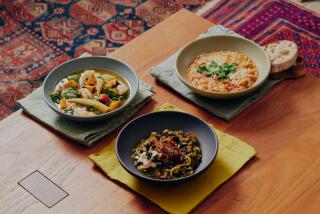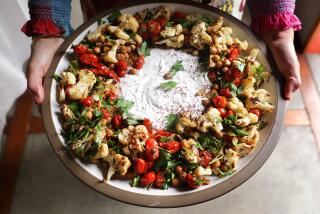More than just artful
Since childhood, I have loved watching TV chefs cut vegetables. The blur of the knife, perfect slices dropping like dominoes behind nimble fingers with nary a Band-Aid in sight -- like professionals in any field, they make it look so easy. I remember dreaming that someday those would be my hands, my knife, zipping through the produce.
So when I enrolled in culinary school and got my tool kit, the smile reflected in my shiny, new 10-inch chef’s knife was one of pure joy. Dreaming that old dream of flying fingers and perfect cubes while idly thumbing the blade, I promptly cut myself. First lesson learned and I hadn’t left the house.
The journey through culinary school is a whirl of methods, ingredients, recipes and tools. But there’s one constant: a focus on knife cuts. As I progressed, slicing, dicing, chopping and mincing became rondelle, macedoine, paysanne and brunoise. It turns out that with a few helpful hints, a bit of practice and a sharp knife, great knife technique really is easy. (Well, perhaps not the knife-blurring speed part.)
There are good reasons for learning to make consistent cuts. Whether you’re sauteing, steaming or baking, smaller pieces cook faster than larger ones. The best way to ensure even cooking is to make the pieces the same size.
Another reason is that well-cut foods simply look great. Nothing elevates a vegetable dish from ho-hum to oh, my! like a well-executed cut. Mix tiny cubes of brunoise carrots, for example, into a pilaf or tiny sauteed Brussels sprouts (halve or quarter them if they’re large), and the visual effect is spectacular.
One of my favorite cuts is the tourne (from tourner, “to turn,” in French). There are different ways to “turn” vegetables. The traditional method results in what look like small seven-sided footballs. This cut works well with root veggies like carrots, potatoes and turnips, but takes a lot of practice to produce consistent results.
On the other hand, a simple yet striking adaptation is to turn summer squash as we do in our recipe for glazed tourne zucchini. The idea is to retain the bright exterior of the green and yellow squash while cutting it into small leaf-shaped ovals. With the shimmering glaze and vibrant colors, it makes an impressive side dish.
Start by cutting the zucchini into segments about 2 inches long; this should yield two or three sections depending upon the size of the squash. Then cut each segment in half from top to bottom (thirds or quarters if the segments are very wide) to get pieces with skin about 1 1/2 -by-2 inches wide. Holding a segment with the skin side up, trim the sides in a sweeping, tapered arc to a basic leaf shape. They should be about 2 inches long, 1 inch or so wide. Cut the seed/flesh side flat so it won’t roll off the plate and the tourne is about three-fourths-inch thick.
A few quick cuts to trim down the sharp angles and they start to resemble tiny ships. A veritable zucchini armada. (There will be quite a bit of scrap left after commissioning this delectable fleet, so save it to flavor a veggie stock.)
Another dish that’s elevated by fine knife cutting is a chicken soup with julienne vegetables. Quite simply, the knife cuts make this soup. The broth is rich and flavorful, and with the texture of the juliennes there is no need to add rice or noodles for body. The knife cuts add a dimension that literally takes the place of additional ingredients.
To julienne, begin by cutting the vegetable into 2-inch-long segments. Next, cut a flat spot on a rounded side for a base and start cutting vertical slices, or planks, one-eighth-inch thick. The planks can then be stacked, and one more cut of one-eighth inch has perfect juliennes tumbling onto your cutting board. To turn these into brunoise or small dice, line up a stack of juliennes. One more one-eighth inch cut creates the tiny cubes. By adjusting the width you change from julienne to batonnet, from brunoise to macedoine, just like a real TV chef.
One of the most valuable knife techniques in the future chef’s arsenal is the proper way to chop an onion or brunoise a shallot. For beautiful, even dice from an unevenly layered onion or shallot, cut the bulb in half vertically (through the root end), to make a stable base. Use a thin, sharp knife to make a series of vertical cuts of even width toward the root end (but without cutting through it, so the bulb stays together), then make horizontal slices, and slice across all those cuts.
Chefs know that just about any plain sauteed fish or chop looks marvelous dusted with finely chopped parsley. But how do they get it so fine and fluffy? You’ll need a sharp knife. Remove the stems, then wad the leaves together and chop through them, moving the knife over a bit with each stroke. Turn your knife 90 degrees and chop through them again. Repeat until the parsley is as fine as you desire. Now scoop up the parsley, put it in cheesecloth or a towel, twist it closed and rinse under cold water. Then squeeze out as much moisture as possible. Open the towel to reveal light and fluffy chopped parsley, a perfect final touch.
*
Chicken soup julienne
Total time: 1 hour, plus about 6 to 8 hours simmering and overnight chilling
Servings: 8 to 10 (makes 14 cups)
Note: You may substitute chicken legs, thighs and wings if you can’t get backs and necks. It will make a lighter-bodied broth.
Chicken stock
5 pounds chicken bones: backs, necks and wing tips
5 quarts cold water
2 onions, quartered
1 cup coarsely chopped carrot
1 cup coarsely chopped celery
1 bouquet garni (made of 1 bay leaf, 2 sprigs thyme and 5
sprigs flat leaf parsley tied in
2 green 7-inch long leek leaves)
1. Place the chicken bones in a stockpot and cover with the water. Slowly bring to a simmer, frequently skimming the scum that floats to the surface. When the stock is simmering, skim it again and then add the vegetables and bouquet garni.
2. Simmer for 4 to 6 hours, partially covered, skimming occasionally. Strain the stock through a fine strainer or chinois into a clean pot and then cool it in an ice bath until cool to touch. Cover and refrigerate overnight. Remove fat from the surface. Makes about 4 1/2 quarts.
Soup
4 quarts chicken stock
3 pounds chicken leg-thigh combos, skin and fat removed
1 herb sachet (made of 1 bay leaf, a clove, 1 whole peeled garlic clove, 2 sprigs fresh thyme, 3 sprigs flat leaf parsley and 4 whole black peppercorns tied in a piece of cheesecloth)
2 cups leeks, whites only, cleaned, julienned
1 cup carrots, peeled, julienned
1 cup celery, julienned
4 teaspoons kosher salt, or to taste
1/4 teaspoon freshly ground black pepper, or to taste
1. Bring the chicken stock to a simmer in a large stockpot. Stock should be gently agitated, not at a rolling boil.
2. Add the chicken and sachet to the stock, cover and gently simmer for 1 1/2 hours, skimming occasionally.
3. Remove the chicken to a colander to cool. Shred the chicken and discard the bones.
4. Add the vegetables to the stock and simmer until tender but not soft, about 10 to 15 minutes. Discard the sachet.
5. Return the chicken to the soup. Adjust the seasoning with salt and pepper to taste. Serve.
Each of 10 servings: 184 calories; 22 grams protein; 7 grams carbohydrates; 1 gram fiber; 8 grams fat; 3 grams sat. fat; 64 mg. cholesterol; 999 mg. sodium.
*
Glazed tourne zucchini
Total time: 45 minutes
Servings: 4 to 6
1 pound golden zucchini (about 2 large)
1 pound zucchini (about 2 large)
Salt
1 1/2 teaspoons sugar
4 tablespoons butter, cut into 4 pieces
1. Cut the zucchini into tournes; you should get 6 to 8 per squash. Fill a medium saucepan with water. Add salt and bring to a simmer.
2. Add the zucchini and gently simmer until just tender, not soft, about 5 to 6 minutes. Drain and set aside.
3. While the zucchini simmers, make the glaze. Heat 2 tablespoons water, the sugar and a pinch of salt over medium heat in a medium saute pan. When the water is hot, add the butter, one piece at a time, whisking constantly. When all butter is melted and the glaze is smooth, add the tournes. Toss gently to coat, and serve.
Each of 6 servings: 98 calories; 2 grams protein; 7 grams carbohydrates; 2 grams fiber; 8 grams fat; 5 grams saturated fat; 21 mg. cholesterol; 36 mg. sodium.
*
Potatoes with bacon and scallion confetti
Total time: 25 minutes
Servings: 4
Note: From Donna Deane. Bacon will cut more easily when it’s very cold.
2 pounds red potatoes (about 4 large)
1/4 pound bacon, about 6 slices
1 teaspoon salt
1/4 teaspoon black pepper
1 clove garlic, minced
1 tablespoon finely chopped green onion (green part)
1. Cut off the sides of each potato to make a rectangle. This will make it easier to cut into uniform cubes. Leftover potato pieces can be saved for another use such as soup.
2. Cut each trimmed potato lengthwise into half-inch-thick slices. Lay the slices flat and cut lengthwise into half-inch logs then crosswise into half-inch cubes. Set aside while preparing the bacon.
3. Cut each slice of bacon in half lengthwise, then crosswise into half-inch pieces. Cook the bacon in a large nonstick skillet over medium heat until crisp, about 5 to 8 minutes, stirring occasionally. Remove the bacon to a paper towel and let it drain.
4. Add the cubed potatoes to the hot bacon fat in the skillet and cook over medium-high heat, shaking the pan to prevent sticking and to allow the potatoes to brown on all sides. Cook 3 to 4 minutes until potatoes begin to brown. Season with salt and pepper.
5. Cover and cook over medium-low heat until the potatoes are tender, 8 to 10 minutes. During the final 3 minutes of cooking, stir in the garlic.
6. Uncover and cook over medium-high heat until the potatoes are browned, about 3 to 4 minutes.
7. Remove the potatoes from the skillet to a serving platter and sprinkle with bacon and green onion.
Each serving: 172 calories; 5 grams protein; 27 grams carbohydrates; 2 grams fiber; 5 grams fat; 2 grams saturated fat; 8 mg. cholesterol; 737 mg. sodium.
More to Read
Eat your way across L.A.
Get our weekly Tasting Notes newsletter for reviews, news and more.
You may occasionally receive promotional content from the Los Angeles Times.










